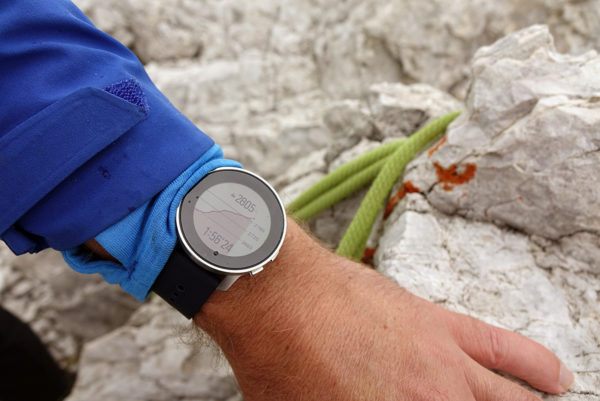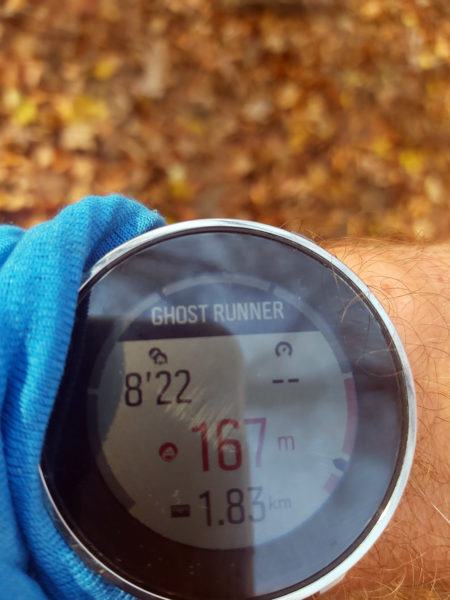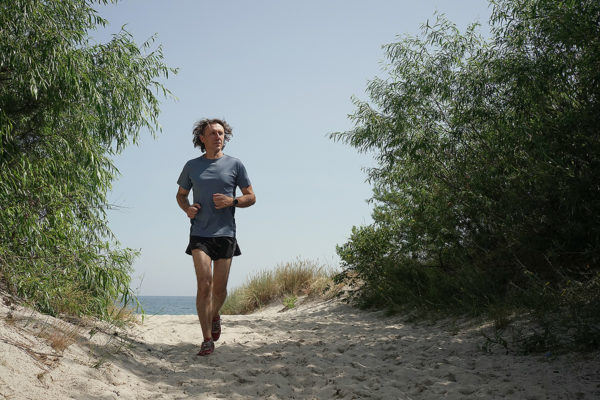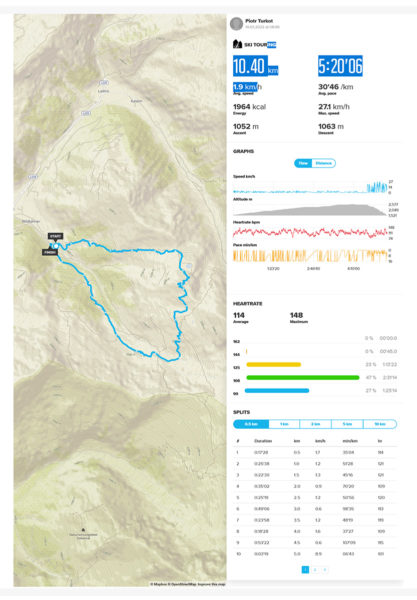
Test: the Suunto 9 Peak watch
Another advantage of 9 Peak is the altimeter, whose operation is based on barometric pressure (the watch is equipped with a pressure sensor) – here is the altitude of the Campanile Alto crag indicated (without the FusedAlti function) with an accuracy of 2 meters, according to the map 2937 m), fot. outdoormagazine.en
Last year’s novelty from Suunto, the Suunto 9 Peak, is a model touted as the thinnest, smallest and most rugged sports watch in the Finnish manufacturer’s collection. Peak is also for outdoor sports enthusiasts, monitoring their activities, appreciating the rich set of options and functionality, but also those who appreciate decent and minimalist Scandinavian design on a daily basis. Is it all true? We checked.
 The Suunto Peak 9 is different from most watches (also in the Suunto family) it is smaller, thinner, lighter and its design is more subtle (pic. outdoormagazine.pl)
The Suunto Peak 9 is different from most watches (also in the Suunto family) it is smaller, thinner, lighter and its design is more subtle (pic. outdoormagazine.pl)
At the outset, I must point out that I am not a specialist in the subject of sports watches. What follows is that my review will contain the observations of a rookie who is beginning his adventure with an advanced chronometer. However, the Peak 9 accompanied me not only in daily (office) activities, but also during climbs and hikes in the mountains and rocks, I ran with it at the sea and in the forest, cycled off-road and on-road. So how did I manage to tame the 9 Peak?
Construction, design
We have to admit that already the first impression is good. The Suunto Peak 9 is different from most watches (also in the Suunto family) it is smaller, thinner, lighter and its design is more subtle. Size – 43 x 43 x 10.6 mm – matters, of course, affects not only the weight (52 g), but also the size of the display. What’s more, the model is equipped with sapphire glass and a body made of titanium (grade 5) and glass-reinforced polyamide. Water resistance of up to 100 m is also an important feature.
 The size of the Suunto 9 Peak is: 43 x 43 x 10.6 mm; weight: 52 g. The model is equipped with sapphire glass and a body made of titanium (grade 5) and fiberglass-reinforced polyamide (photo. Suunto)
The size of the Suunto 9 Peak is: 43 x 43 x 10.6 mm; weight: 52 g. The model is equipped with sapphire glass and a body made of titanium (grade 5) and fiberglass-reinforced polyamide (photo. Suunto)
I found out whether this is a durable piece of kit while climbing in the Dolomites and rocks. It happened many times not only hooked, but also hit the rock. I scrubbed both the strap and the glass on the rock, many times the watch fell on the sandy beach, and since the beach, swimming in both salt water and the increasingly fresh Baltic Sea. A lot of outdoor activities but all in all, the most dangerous moment I had while walking on the sidewalk and reading the newspaper – the sound of hitting a roadside trashcan still rings in my ears… 😉 Fortunately, the glass of the watch did not break… After 3 months of use there are no scratches on the glass, one scratch I notice on the titanium bezel.
The 9 Peak’s 22-millimeter wide strap is made of silicone, while being very soft and holding the watch perfectly on the wrist. The clasp is quite comfortable – although at first you may have a bit of trouble pushing the pin (metal pin) into the unworked hole. All in all, the whole thing is comfortable, but there are times when the end of the strap detaches – a more abrupt snag on some protruding object, rock, branch.
On the other hand, in only superlatives I can describe the design of the 9 Peak. The minimalist design and finishes, as well as the reduction in size, look great. In doing so, they give a model that wears very well, in fact, you forget that you have it on your hand – which I can not say about some other watches, or bands. It is not insignificant that the watch performs well in out-of-doors situations – it goes well with a jacket (visiting a wedding) and more elegant than a sports blouse, clothes. 9 Peak does not “epitomize” its size, but emphasizes in a subtle way the belonging (or just aspirations…) of the owner to the active sports community 🙂
Information, features
The most important thing, of course, are the functions that the watch offers to active users. This is because 9 Peak allows monitoring and recording of many activities. We navigate with three titanium buttons and a touch screen.
The screen itself is a few millimeters smaller in diameter than the entire watch glass. The resolution of the display is 240×240 pixels. Its additional feature is automatic brightness adjustment depending on the surrounding light. We can choose one of the modes permanently, or let it adjust automatically. Backlighting enhances the contrast of the display – without it, the screen is not clear enough. In semi-dark conditions – running in the woods etc. – the lack of contrast makes itself felt. At this point I have to mention that the font size used in the watch is quite small – normally I use glasses for reading and also in the case of reading the messages in 9 Peak glasses are helpful for me. The problem is that I don’t wear them outside of reading, and certainly don’t use them during hikes, workouts and daily activities. But of course, this is my personal problem and not a defect of the watch 🙂
Let’s go back to navigation – switching between modes and functions is simple, although sometimes not entirely intuitive. You need to remember the order of selection based on navigation up and down (extreme buttons) and horizontally (middle button) or touch screen swiping. Entering the information the watch provides is done by switching the bottom button (or sliding the screen), one by one we get individual data (steps, heart rate, last workout, altitude, sleep, fitness level. Stress), in turn, within them we already move with the middle button (horizontally). Pressing the top button – when we are at the standard level (time and date display) – takes us to the functions: exercise, navigation, log, stopwatch, settings. And further when we want to move within the functions we navigate with the middle button, and message confirmations again using the top and bottom buttons.
9 Peak is equipped with a heart rate sensor and, a novelty, a blood oxygen level measurement. Covid has caused many people to not only learn about saturation, but to start monitoring it as well. I in my first aid kit have a pulse oximeter, so I was able to compare the readings of this sensor with what the watch shows. However, measuring “oxygen” takes the watch a relatively long time (20-30 seconds). The 9 Peak measurements taken in this way are mostly in agreement. However, when we look at the results “recorded” by the watch, they are often below the norm – between 89 and 93%. Deviations in the case of “static” measurement also happen, but then you need to clean the sensor – everything should return to normal. In turn, heart rate measurements coincide with pulse oximeter readings. It is necessary to always take into account whether the watch fits well on the wrist etc.
Suunto 9 Peak uses 4 GPS (American navigation system) measurement modes:
- GPS+QZSS (Japanese regional system)
- GPS+QZSS+Glonass (Glonass – Russian.)
- GPS+QZSS+Galileo (European)
- GPS+QZSS+BeiDou (BeiDou – Chinese)
The 9 Peak also has the advantage of an altimeter, the operation of which is based on barometric pressure (the watch is equipped with a pressure sensor). The accuracy of the indication can be increased by defining a reference point – the known altitude n.p.m. In addition, we can use the FusedAlti function, which uses barometric altitude readings and GPS.
 Another advantage of the 9 Peak is the altimeter, whose operation is based on barometric pressure (the watch is equipped with a pressure sensor) – here is the altitude of the Campanile Alto crag indicated (without the FusedAlti function) with an accuracy of 2 meters, according to the map 2937 m), photo. outdoormagazine.en
Another advantage of the 9 Peak is the altimeter, whose operation is based on barometric pressure (the watch is equipped with a pressure sensor) – here is the altitude of the Campanile Alto crag indicated (without the FusedAlti function) with an accuracy of 2 meters, according to the map 2937 m), photo. outdoormagazine.en
Battery
The advantage of 9 Peak is long battery life. In normal watch mode, it is, according to the manufacturer, 14 days, and it must be said that in fact the battery lasts more than 10 days without any problems, with several activations of training modes (for approx. 1-2 hours). Another big plus is fast charging – after approx. one hour we have 100%. For charging, there is a USB cable terminating in a charging element attached to the watch with a magnet.
 The charger itself – USB cable – attaches to the watch with a magnet (fot. Suunto)
The charger itself – USB cable – attaches to the watch with a magnet (fot. Suunto)
For more intensive use of the modes (with GPS enabled), we have the following operating times in the specification: Performance (default) 25 hrs. Endurance 50 hrs. Ultra 120 hrs. and the most economical Excursion 170 hrs. The last two disable heart rate tracking (you can change these standard settings to your own – at the expense of battery life, of course). During any activity, we can choose from the above modes – info on battery life will appear at the top of the screen.
In daily use, when workouts do not last many hours, battery consumption – as I have already mentioned – is slow. The viability I had the opportunity to test in the Dolomites during a 3-day mountain trip. The watch monitored daily hiking and climbing activities – a total of 24.5 hours (in Performance mode), and the battery lasted a total of more than 72 hours.
 An interesting addition in the 9 Peak is the Snap to Route – Set Route option (fot. outdoormagazine.pl)
An interesting addition in the 9 Peak is the Snap to Route – Set Route option (fot. outdoormagazine.pl)
New features – Snap to Route – Preset Route
An interesting addition in 9 Peak is the Snap to Route – Tasked Route option. With this function, the GPS track tries to stick to the set route, minimizing inaccuracies due to possible distortions in the GPS reading (which can be affected, for example, from running in a leafy forest or urban environment). “Set Route” can be found in the Exercise options, here an important note – the function must be activated before starting the activity. The watch will record the location on the route, without creating a new path. As long as we do not move more than 100 meters away from the “original”. When this happens, the actual position measurement is made and the route record is changed. Sticking to the preset line results in the best monitoring, even of running pace, otherwise large deviations from the preset route will introduce inaccuracies and, as a result, the record and results of the exercise will not be reliable.
Navigation „turn by turn” can be found by logging into Komoot.com. By belonging to the Komoot community, you can use the trail database (after syncing with the watch in the Suunto app). When we start using navigation on Komoot trails, the watch will give us instructions related to the direction of movement, adding audio warnings to it.
New features – Burner
Thanks to the watch’s reports, we can monitor various training data. The SuuntoPlus package includes another interesting feature, which is the Burner function. Its operation is simple – you need to run it before you start exercising in the SunntoPlus menu – and the effect provides knowledge of how fast you burn fat and carbohydrates (the result is given in grams per hour). An additional piece of information is the percentage of calories burned from fat.
 Ghost Runner function in Suunto 9 Peak – current pace appears in the upper right corner. The main value, on the other hand, in the center of the screen indicates the distance from the virtual runner – a positive value means that you are “winning” (pic. outdoormagazine.pl)
Ghost Runner function in Suunto 9 Peak – current pace appears in the upper right corner. The main value, on the other hand, in the center of the screen indicates the distance from the virtual runner – a positive value means that you are “winning” (pic. outdoormagazine.pl)
New features – Ghost Runner
This feature can add variety to training, especially for those of us who have a touch of competition in us. In 9 Peak, our “opponent” becomes Ghost Runner – a virtual runner, against which we can analyze the pace of running. The feature is located in the Suunto Plus menu and, as with Burner, must be activated before activity. Importantly, during exercise, we can select one of the Plus modes, so I have no way to get Burner results when the Ghost Runner function is active.
Ghost Runner works most intuitively and reliably when we run along a route already stored in memory. Then the pace refers to the best result obtained. Of course, the important thing in this case is whether we want to race, or whether the GR readings are only informative for us. GR can be used in various settings – target distance, duration, or target pace.
 A lazy run can be spiced up with Ghost Runner – a virtual runner that becomes a reference point for us (pic. outdoormagazine.pl)
A lazy run can be spiced up with Ghost Runner – a virtual runner that becomes a reference point for us (pic. outdoormagazine.pl)
Target pace appears in the upper left corner of the screen – it is determined on the basis of the first kilometer (which is a problematic solution – after all, the beginning of a run is not always an indicator of our pace). The only option to set your own pace is to assign the current one (the measurement will appear earlier than after the first kilometer) to a lap and return to the GR screen – then the app will refer to the “entered” new pace.
Current temp in GR appears in the upper right corner. Meanwhile, the main value, in the center of the screen, indicates the distance from the virtual runner – a positive value means that we “win”.
 The application allows us to analyze the data obtained during workouts and trips – here a summary of a run in the Wolski Forest in Krakow (photo. outdoormagazine.en)
The application allows us to analyze the data obtained during workouts and trips – here a summary of a run in the Wolski Forest in Krakow (photo. outdoormagazine.en)
Suunto app
It is difficult to imagine a modern watch without an additional interface. And such a clear panel for easy interaction with the 9 Peak (and not only with the model) is undoubtedly the Suunto APP mobile app. With its help we get all software updates, information about new features and technological curiosities. Above all, however, the app allows us to analyze the data obtained during training and excursions, as well as manage our account and its settings. After synchronizing the watch and the app, it shows them clearly. The maps on which the GPS record is drawn are aesthetically pleasing and accurate. Information about our exercise is gathered in several charts, containing figures related to the activity performed. In addition, there will be graphs of Heart Rate Zones, NPM Heights. We can transfer the info gathered in this way to any device and communicator.
 The maps on which the GPS record is drawn are aesthetically pleasing and accurate. Information about our exercise is gathered in several charts, containing figures related to the activity performed – here skitouring (fot. outdoormagazine.pl)
The maps on which the GPS record is drawn are aesthetically pleasing and accurate. Information about our exercise is gathered in several charts, containing figures related to the activity performed – here skitouring (fot. outdoormagazine.pl)
Suunto 9 Peak – a companion for every day
Yes, the new 9 Peak has a lot of current news for us. Eagerly inquires about our well-being, satisfaction with the training we just did. Provides information about the level of stress, fitness. “Worries” about us sleep… Most importantly, however, it has motivational capabilities. I, in any case, like to look at the watch screen, which shows the days of the week – a red dot certifies that a given day’s training has been completed. When there are a lot of dots then I have a sense of duty fulfilled 🙂 Of course, when they start to run out then there will be remorse, and can’t they be a motivating factor?!
 Suunto 9 Peak allows us to monitor and collect data of our effort during a wide variety of activities from standard ones like running, swimming, cycling, biathlon or trekking to more “niche” ones like indoor climbing, skitouring, cross-country running (fot. outdoormagazine.en)
Suunto 9 Peak allows us to monitor and collect data of our effort during a wide variety of activities from standard ones like running, swimming, cycling, biathlon or trekking to more “niche” ones like indoor climbing, skitouring, cross-country running (fot. outdoormagazine.en)
When we add the aforementioned features and many other conveniences (constantly updated by Suunto), data to facilitate monitoring of training and our efforts – many different activities from standard ones like running, swimming, cycling, biathlon or trekking to more “niche” ones like indoor climbing, skydiving, cross-country running (the list of sports and accompanying data is constantly updated) – we get an extremely useful tool to support our active lives.
A tool that is not only useful, but also was created with an eye to modern design, and in the production of which durable and advanced technologies and materials were used. In a word – recommended.


